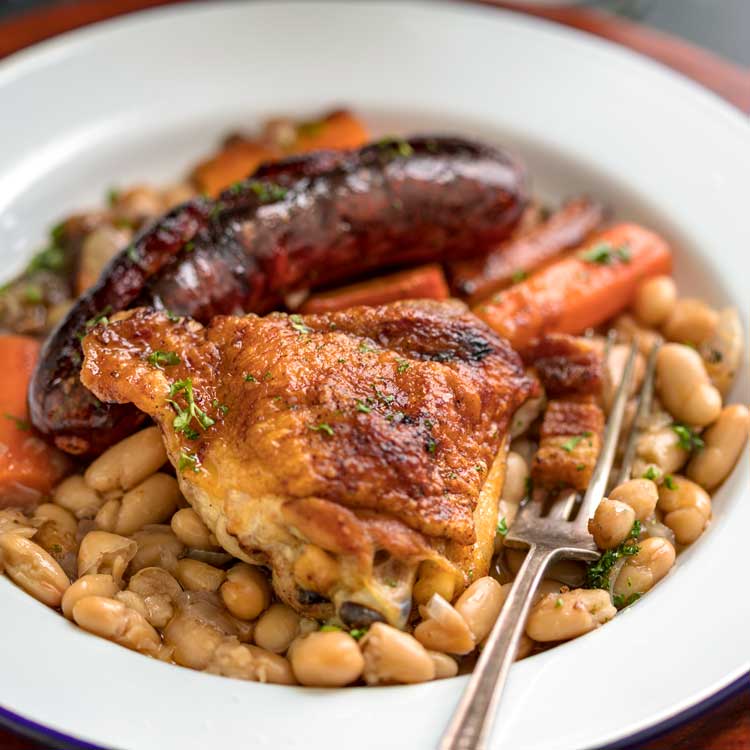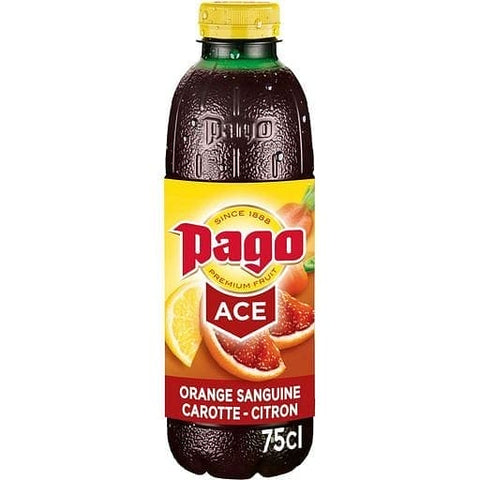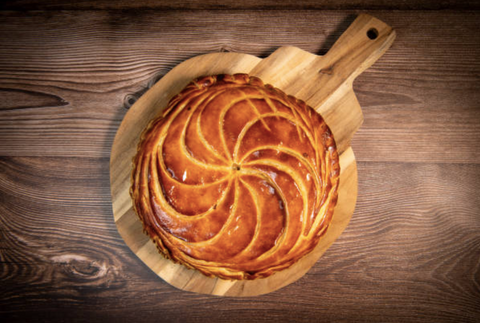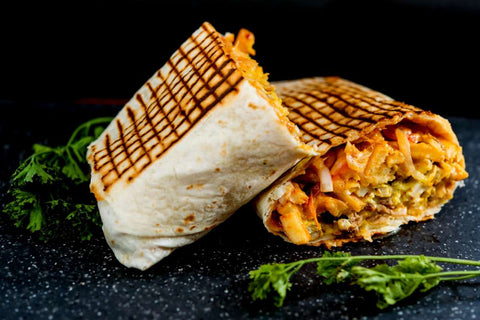A cassoulet is a rich, slow-cooked casserole originating in the south of France, containing meat (typically pork sausages, goose, duck, and sometimes mutton), pork skin (couennes), and white haricot beans (haricots Blancs). The dish is named after its traditional cooking vessel, the castle, a deep round earthenware pot with slanting sides.
What is cassoulet?
Cassoulet is a slow-cooked bean stew or casserole originating in the south of France. It typically contains meat (such as pork, goose, duck, and mutton), pork skin (couennes), and white haricot beans and may also include Toulouse sausage.
The dish originates from the French town of Castelnaudary, whose name derives from the Occitan word castelnaüdarii, or "castle of the new pond." There are many legends surrounding its creation and many variations throughout France.
Regional variations of Cassoulet
Cassoulet is generally made by layering meats with beans and other ingredients in a cooking vessel. Cassoulet of Toulouse is made with white beans, duck confit, and sausages. The Carcassonne version adds haricots Blancs tarbais and is usually made with mutton. The recipe from Castelnaudary uses local eels and lamb along with beans and pork skin. In Pézenas, the goose is added instead of the duck. The cassoulet of Lauragais has no duck or goose fat as it was historically a dish for the poor; it does contain small pork sausages here are ingredients mentioned in seriouseats website.
The key ingredient is the bean;
- Dried haricot beans are soaked overnight then simmered gently with garlic until tender.
- The other ingredients are fried separately and served on the beans in layers. The dish is baked until the top layer is crunchy and golden brown and the interior is soft and flavorful.
Variations in French Cassoulet
It is a dish in many variations, but it is generally made with white beans and some animal (duck, goose, lamb, and pork), sometimes two or even all three. There's a lot of controversy over what constitutes a true cassoulet, and the only thing that seems to be universally agreed upon is that beans are involved.
What do the French serve with cassoulet?
Cassoulet is a hearty stew formed from white beans, meat, and seasonings and cooked slowly in a heavy casserole. It originated in the southwest of France, in the Languedoc-Roussillon region.
The meats commonly used are duck, lamb or mutton, pork, and sausage. You'll see goose or chicken used in many recipes instead of duck. Even though it takes several hours to cook, it's very easy to make. You just put everything in the pot at once (except for the sausage), then walk away until it's done.
- You can serve cassoulet on its own with a salad and bread on the side, but it's traditional to accompany it with something colorful . . . usually greens of some sort.
- If you're looking for a great meal to prepare for the colder weather, try making a cassoulet. This traditional French recipe typically includes pork sausage, duck confit, and white beans. Unfortunately, while the meat is delicious, it's not the healthiest dish out there.
- To balance out your meal and add more nutrients, you'll want to serve a side dish with your cassoulet.
Here are some healthy options that go well with this hearty dish:
- White rice: The texture of white rice makes it a perfect complement to cassoulet. When choosing a type of rice for this dish, consider basmati or jasmine because they're packed with more flavor than other varieties. Also, make sure you serve brown rice instead of white to keep things healthy.
- Roasted potatoes: Potatoes are a great side dish to pair with cassoulet because they help soak up all the rich meaty sauce. The key to making sure your potatoes taste great is to roast them in olive oil and fresh herbs, such as rosemary or thyme. You can also experiment by adding different types of potatoes to your dish. Sweet potatoes are a popular option because they contain more nutrients than regular russet potatoes.
- Steamed vegetables: Vegetables offer plenty
Cassoulet is a Healthy Food
A traditional cassoulet is loaded with calories, but who cares? It's served at festivals, weddings, and other celebrations. It's the perfect comfort food for cold winter nights or after a hard day of labor. A slice of country bread (and sometimes even cheese) makes it a complete meal, but if you want to be decadent, serve it with a glass of full-bodied red wine.
The whole point of cassoulet is the beans, which are the dish's foundation. Therefore, they should be expensive, high-quality dried beans, not canned or precooked.
The traditional bean for cassoulet is Tarbais, named after the town in Gascony where they are grown. These kidney-shaped beans are creamy and large — perfect for a rich stew-like cassoulet. Unfortunately, they're very hard to find outside France, but you can buy them online and can get help from cooking nytimes.
Haricots Tarbais and other French beans such as Lingots (white kidney beans) or Coco de Paimpol (cranberry beans) are typically sold in 1-kilo bags — more than enough for most recipes.
French cassoulet can be made with some different types of beans and meats.
- The original recipe calls for white beans, but some cooks also mix other dried legumes, including borlotti, navy, and cannellini beans.
- The meats in cassoulet typically include pork sausages, goose or duck confit, and mutton or lamb.
- The ingredients are slow-cooked in a deep dish oven in layers. Cooks often make their bean broth by simmering the beans with garlic, onions, and herbs. Next, they brown the meat and sausages in a separate pan before adding them to the bean broth. Finally, they add croutons to the top, drizzle with olive oil, and bake until golden brown.
Cassoulet is a popular regional dish that is both filling and hearty. Some cooks add white wine to the bean broth before layering the cassoulet to give it more flavors, while others include other herbs like thyme or rosemary.

Try a cassoulet with Navy beans
The word cassoulet derives from the Provençal word for cauldron, and the dish is traditionally cooked in a large round earthenware pot. The plate has its roots in the cuisine of Southern France. It is most commonly associated with the provinces of Toulouse and Castelnaudary; both are situated on the Aude River banks (the first use of the word dates to 1788, although many believe that it was prepared much earlier).
The next best choice would be cannellini beans, also called white kidney beans. They have a similar texture and flavor but are not as delicate as tarbais. They are larger than tarbais and have thicker skins that don't break down during cooking and you can try the recipe of thekitchn website.
Cannellini is much more common in the UK than tarbais, so cannellini will work well enough if you can't find tarbais.
A cassoulet is typically a bean stew from the French region of Languedoc (southern France), consisting of beans, salt pork, and mutton. There are many regional variations, but the ingredients are typically combined in a heavy pot and baked for several hours. The dish has been around for hundreds of years.
The recipe traditionally uses;
- Duck legs and sausages and mutton or lamb shoulder for the pork, but there are also versions using only pork or only duck – so really, use whatever you want!
- Beans are a major staple in many cuisines — and there's no better way to appreciate them than by trying out the classic French cassoulet.
- Cassoulet is a stew of white beans, duck confit, pork sausage, and garlic sausage baked with herbs, spices, and tomatoes.
- The ingredients vary widely from region to region in France, but the basic principles remain the same: slow-cooked beans combine with flavorful meats to create a dish that's rich, hearty, and filling.
The secret to this dish is starting with dried beans that you cook yourself. Canned beans are already cooked and will fall apart if you bake them for more than 30 minutes. Soaking dried beans overnight removes a lot of their indigestible starches (which cause gassiness),
A cassoulet is a hearty stew that originated in the southwestern region of France. The dish includes beans, meat, and sometimes vegetables.
Most cassoulet recipes include white beans as their bean of choice. White beans are a great source of fiber, potassium, and folate. They're also full of protein!
Freezing a Cassoulet
Absolutely! Cassoulet is the perfect make-ahead dish. Assemble it up to a week in advance and keep it covered in the refrigerator. When you're ready to bake, let it sit out for about an hour, then add about 15 minutes of extra cooking time to account for the cold food.
If you want to freeze the cassoulet, assemble and cook it as usual, then let it cool completely. Freeze in the casserole dish or transfer to a freezer bag. Thaw completely in the refrigerator overnight before reheating.
Reheating a Cassoulet
The short answer is no. Like most stews, the texture of a frozen and reheated cassoulet is likely to be grainy or mealy.
But there are some tricks you can use to salvage a leftover cassoulet.
- Start by removing the beans from their cooking liquid.
- Reserve them in a separate container. Then, pour the duck fat off the top of the stew, leaving just enough to cover the beans and meat (about 1/4 cup).
- Next, steam-blanch some fresh haricots verts until they are tender, then add them to the beans and refrigerate.
When you're ready to reheat, put the casserole on top of the stove over medium heat. Add back enough of that reserved cooking liquid to make it soupy, and then bring it back up to temperature. Next, add the reserved beans, along with any green beans that may have collected in the bottom of their container (to save time, these can be reheated in their cooking liquid instead of being blanched). Continue cooking until everything is hot through. Then serve with lots of crusty bread and a simple green salad.
Season for eating Cassoulet
The dish originated in the south of France during the winter months, and it has since become a staple of French cuisine. The dish is usually made with white beans, duck confit, and sausage, though many variations. The French will typically eat cassoulet in fall and winter.
Cassoulet is better in the next day
In the cassoulet, the duck fat acts as a binder that helps hold the beans and sauce together. This means that it's even better than the first day when the cassoulet is reheated. The flavors have melded together and become even more concentrated.
It's also better the next-next day and even the day after that. As it sits in its pan, stewing away in the coolness of an unheated kitchen, it mellows, its flavors grow deeper, and it gets creamier and silkier.
- Fill a large bowl with water and soak the beans overnight. Drain and rinse them, then put them in a large pot with one tablespoon of salt and enough water to cover the beans by about 4 inches. Bring to a boil, then reduce the heat to medium-low and simmer until tender, about 1 hour.
- Meanwhile, add the pork skin to another large pot of cold water (you may need two pots). Bring to a boil over high heat, then reduce the heat to medium-low and simmer for 1 hour (this will render some of the fat). Remove from the pot with a slotted spoon or tongs and let cool on paper towels. (Leave the rendered fat in the pot.)
- Measure out 3 tablespoons of rendered fat (or use olive oil) and return it to the pot over medium heat. Add the carrots, turnips, and onions, season with salt and pepper, and cook until softened, 8 to 10 minutes. Add the garlic and cook until fragrant, 90 seconds more. Transfer to a plate; once cooled slightly, finely chop half of it and leave half whole (for garnish).
- Season the pork belly all over with salt and pepper; add it to the pot along with any remaining rendered fat.




